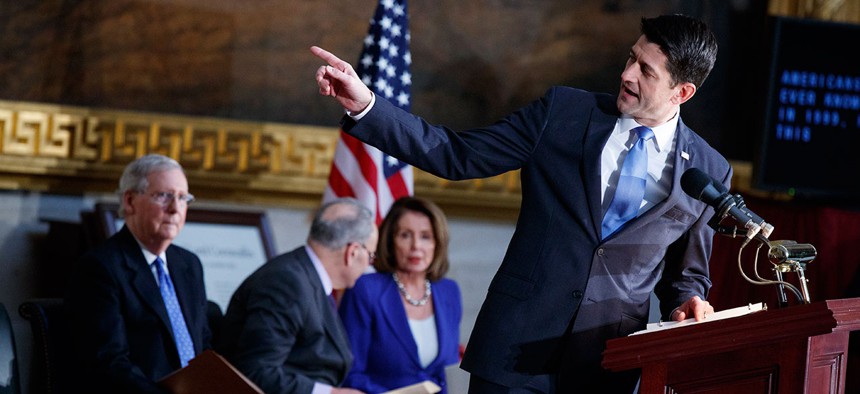
Paul Ryan speaks in front of Mitch McConnell, Chuck Schumer, and Nancy Pelosi on Capitol Hill on January 17. Evan Vucci/AP
Analysis: The Real Cause of the Last Government Shutdown—and the Next One
Republican leaders have proven unable to enact any spending bills, despite controlling both houses of Congress.
For Chuck Schumer and his Senate Democrats, the reaction since the government shutdown ended has been nothing short of brutal. Schumer and his colleagues are being hit from all sides: Trump and his acolytes like Brit Hume who are contemptuous of the cave-in, pundits like David Brooks decrying their ineptitude, progressives and Dreamers screaming about betrayal. It all fits the penchant of journalists and pundits to focus on winners and losers. Before the shutdown, the focus was on the negotiations over DACA, the president’s outbursts and reversals, whether all this would lead to a shutdown, whether it would be a Schumer shutdown and a Trump shutdown, and who would pay a price or benefit politically. Of course, these issues and questions are not trivial—any more than an election horserace is trivial. But like the horserace obsession, they muddy up other critical issues. In this case, there is a whole series of important elements to recognize and consider.
Step back and look at the broader context: Why was there an endgame in January 2018 that led to the brief shutdown? It is true that the status of nearly 700,000 recipients of DACA, or Deferred Action for Childhood Arrivals, needed to be resolved ahead of a deadline of March 5. But the fundamental answer is that the Republicans in charge of all three governing entities could not manage to enact into law a single one of the dozen spending bills that make up the discretionary part of the government for a fiscal year that had begun three-and-a-half months earlier, on October 1.
In 2017, as the new fiscal year approached, Republicans passed a continuing resolution punting the need for spending bills until December 8. That was followed by another continuing resolution on December 7, punting it again until December 22, to give time to resolve the issues before the holiday break. That was followed by the third continuing resolution, to carry the government through the holidays, with the disaster of the Gingrich-inspired shutdown in 1995-96 fresh in the minds of Republican leaders. When the deadline of January 19 for that CR loomed, we got the showdown that led to the shutdown, and ultimately to a fourth continuing resolution, which will end on February 8.
So make that—so far—four continuing resolutions for funding most of what government does, still providing no clear guidance for the remaining seven-and-a-half months of the fiscal year. Put shutdown politics and DACA aside for a moment; that is simply pathetic. Consider the comments of Defense Secretary James Mattis in a long letter to Senate Armed Services Chair John McCain. As Defense News summarized it:
Mattis first warns of readiness impacts, stating that 90 days after the start of a CR, lost training is ‘unrecoverable’ due to the need to move onto previously scheduled events. As a result, the Marines will lose out on vital training for coordinated joint fires, while the Air Force will be unable to train a group of pilots needed to refresh a pilot shortage.
The Navy will delay induction of 11 ships, which would push some readiness availabilities into fiscal 2019. The service will also reduce flying hours and steaming days, as well as slow down orders of spare and repair parts. The Army, meanwhile, will postpone all noncritical maintenance work orders until later in the year, as well as restricting home-station training.
Overall, no new military construction projects can begin, which will have an ‘inevitable delay in project schedules and potential increased costs,’ Mattis warns. That includes 37 Navy projects, 16 Air Force projects, and 38 Army projects.
The sentiment in Mattis’s comments is shared by every manager in government and among key contractors. It is difficult enough to plan policy when you operate on one-year budgets, with no certainty about funding beyond that year. It is much worse when you cannot plan beyond a month or a couple of weeks. And it is made worse yet when managers have to spend a great deal of time and resources planning for possible shutdowns every few weeks.
The failure to enact any spending bills is a product of deep disagreements over spending and spending priorities among and between House and Senate Republicans, deeper disagreements between Republicans and Democrats, and the looming problem of the damaging across-the-board cuts called “sequesters” that came about because Congress could not agree on a deficit reduction plan in 2011—primarily because Republicans would not accept a balance that included tax increases along with the major changes they demanded in Social Security and Medicare.
House Republicans passed appropriations bills that restored the sequester cuts in defense and added a good deal more for the military—but insisted on taking that funding out of domestic programs, proposing deep cuts to programs from diplomacy and development, to education and the safety net, to the environment and health. Senate Republicans, faced with losing some their own members to an electoral backlash if they supported this gross imbalance, simply avoided taking the process to its conventional conclusion—passing appropriations bills and taking them to conference committees to work out the differences. They were aware that bringing up spending bills that might force difficult votes would likely end up producing gridlock anyhow, because Democrats would filibuster. (There was another reason: Taking a lot of time debating those pesky spending bills would mean less time for other priorities, like repealing Obamacare and passing big tax cuts for the rich and corporations.)
Both House Speaker Paul Ryan and Senate Majority Leader Mitch McConnell have understood well the perils of this approach. The third CR that was enacted in late December was a heavy lift for Ryan; his Freedom Caucus members do not want an unending set of CRs that preserve the status quo and give them no cuts in domestic programs, while many other House Republicans hate CRs that do not add a sizable additional amount for defense. McConnell faces the Senate’s 60-vote hurdle for passing anything except reconciliation and confirmations—but also the additional challenge of a razor-thin majority that could leave him short even of the 50 votes required from his own members without a filibuster.
Shutdown politics, like debt-ceiling politics (Coming soon to a Capitol near you!), have something in common: They become endgame negotiations where all sides maneuver to get more out of the deal before everyone goes over the cliff. That can be political parties, the president, or even individual lawmakers when the numbers are close enough that one vote can make the difference. The Children’s Health Insurance Program (CHIP) is widely popular across all partisan and ideological lines; it provides health insurance to 9 million kids who otherwise would be left unprotected. It is regularly cited by Orrin Hatch as his proudest legislative accomplishment, done in partnership with Ted Kennedy in 1997.
The program faced expiration at the end of the last fiscal year, on September 30, 2017—and despite its popularity, it received from House and Senate majorities no attention and no action. States that administer CHIP were forced to plan for its demise, with some beginning the process of untethering the children from their insurance protection.
Paul Ryan and Mitch McConnell had turned the program into a bargaining chip, to lure (or force) Democrats to accede to their CR by including a reauthorization for the program. Using 9 million innocent children as hostages is morally reprehensible, but it was a factor in Democrats’ deciding to give in three days into the shutdown.
Democrats voted to reopen the government in exchange for six years of authorization for CHIP, along with a promise of Mitch McConnell to give a clean debate and vote on a DACA fix. There was one bitter pill to swallow—another $31 billion in tax cuts that further undermine the Affordable Care Act. But all Democrats fundamentally conceded was three more weeks on a CR.
So what lies ahead? One scenario is déjà vu all over again; no action in the House even if there is a vote on a bill in the Senate, leading to another fandango over an immigration fix, more intervention by White House aides Stephen Miller and John Kelly, a veto power exercised by nativist lawmakers like Tim Cotton, and another shutdown over another short-term CR. But it might not be one forced only by Democrats; it is not at all clear how many more short-term CRs Freedom Caucus members or conservative Republican senators will tolerate.
A second scenario is that no fix for DACA is enacted by February 8, and Republicans instead propose a new extended CR lasting until the end of the fiscal year—one with enough sweeteners in the form of budget and tax cuts to entice enough Republicans in the House and Senate to win majorities, but not enough to overcome the 60-vote hurdle in the Senate, leading to a more prolonged standoff and shutdown. A variation would be two CRs—the first one separating out defense spending to offer a huge increase, followed by the non-defense items with at least the 15 percent cuts required by sequestration. If Democrats ultimately folded, the repercussions for their party would be far stronger and more devastating.
There is a third scenario, more favorable to Schumer and his colleagues. There could be a DACA deal and a broader immigration package—not far removed from the one Senators Durbin, Graham, Flake and others put together that was blown up by Kelly and Miller after the infamous White House meeting—that gets a debate in the Senate and draws broad bipartisan support, garnering well over 60 votes. With the Dreamer program about to end, the pressure on Paul Ryan to hold a vote would be ramped up—and Democrats would have more traction and legitimacy to use another shutdown to force that vote. Ryan might hold out, but the dynamic would be quite different from the one we have seen so far.
Whichever of these scenarios, or some variation thereof, plays out, the deeper conflicts over spending priorities would not be resolved by them. At some point, immigration notwithstanding, it is more likely that the focus will shift to the House, and the onus will be on Paul Ryan to find a way to get a spending bill through by biting the bullet and supplanting lost Freedom Caucus members with Democrats—a dilemma very familiar to his happily retired predecessor John Boehner. And we cannot ignore the other looming and related issue—the debt ceiling. A shutdown, even for a few days, has major costs to governance, federal employees and many other Americans. A debt ceiling breach would be much, much worse.
But even if the spending bills pass, and the debt ceiling is increased, that will simply reset the table for a replay of these same conflicts and fissures for the next fiscal year, which is rapidly approaching.







